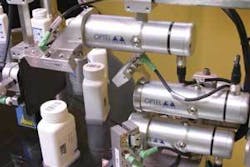Machine vision speeds label verification
Andrew Wilson, Editor, [email protected]
To meet the needs of the pharmaceutical industry, integrated machine-vision systems must do more than simple label verification. Often, manufacturers must change product lot codes containing drug-batch code numbers and product dates of expiration during packaging. Each of these codes must then be individually read and verified, and the presence of any attached documentation, such as an “outsert,” must be correctly verified before individual containers are shipped to hospitals and pharmacies.
Optel Vision (Quebec City, QC, Canada; www.optelvision.com) has developed a machine-vision inspection system capable of controlling the printer on the line and of dynamically verifying all codes on individual labels before they are applied to individual products. “After this is done,” says Phillipe Laberge, sales engineer at Optel Vision, “outserts are attached onto the sides of the products, and their presence is then verified by the same Optel Vision system.”
Large spools of individual “blank” colored labels that may contain the name of the product must first be individually marked with a lot code, an expiration date, and a barcode. As these spools are unwound, each label is presented to an inkjet printer that is interfaced to the Optel Vision system. Using a programmable logic controller (PLC), which is also interfaced to the vision system, each label is indexed under the printing head where the alphanumeric codes and barcodes containing lot, date, and product information are printed on the side of each label. To verify these codes on the labels, a photoelectric sensor triggers a CCD camera as the labels moves along the web (see image).
After each image is triggered by the PLC, it is transferred to the vision system using a frame grabber. Using Optel Vision’s preconfigured software, the image of each alphanumeric code and barcode is isolated within a region of interest and then verified and displayed in real time on the system’s touch-screen HMI. This information is stored in database format within the system. Once verification has occurred, each label is applied to a container.
“Once the label is printed, verified, and applied to the package,” says Laberge, “a paper outsert is attached to the side of the container.” After both label and outsert have been applied, presence of the outsert and the barcode on the outsert must be verified. A second CCD camera, which is mounted on the opposite side of the conveyor, is triggered to image the outsert by a second photoelectric sensor. This camera is also interfaced to the vision system using a frame grabber. Here, too, a region of interest is used to minimize the search area within the field of view and locate the barcode printed on the outsert.
Once each product has been inspected, it is moved along the production line. The system also tracks all products as they pass through the inspection stations. Therefore, should an individual product be improperly or poorly marked or the insert be improperly positioned or poorly marked, the vision system would “know” the precise location of the “bad” product as it moves down the lineup until the system receives confirmation that the product has been diverted into a rejection station.
“In the design of the user interface,” says Laberge, “it was necessary to allow the operator to visualize both inspections as they occur. Furthermore, incorporating a number of easy-to-use setup functions within the graphical user interface makes it is easy for the operator to adjust the machine vision system to accept a variety of pharmaceutical containers.”

